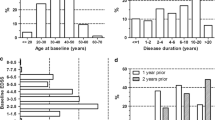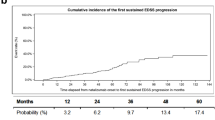Abstract
There is an urgent need to identify the best strategies to prevent the loss of natalizumab (N) beneficial effects after its suspension. The objective is to evaluate the clinical and radiological disease activity and to test the efficacy of immunomodulatory/immunosuppressive drugs (IT) after N suspension. Clinical and radiological data from 54 patients 2 years before treatment (pre-N), during treatment (on-N) and after interruption, during 1-year follow-up (post-N) were retrospectively collected. Annualized relapse rate (ARR), expanded disability status scale (EDSS), presence of new T2 lesions and Gd+ (gadolinium enhancing) T1 lesions were evaluated. Pre-N ARR at 1 year was 1.74 while post-N ARR was 0.94 (p = 0.0053). We observed that post-N disease activity never raised over pre-N levels, neither post-N ARR nor post-N EDSS. In patients retreated with N after suspension, post-N ARR was significantly lower than pre-N ARR (p = 0.017), but not in patients treated with other IT or in patients not treated with any disease modifying drugs (DMD). The mean time of freedom from new T2 lesions and new Gd+ lesions was lower in post-N period compared to on-N (T2 lesions p = 0.0000, Gd+ lesions p = 0.0000). In conclusion, a “rebound” pattern was not identified in our cohort, though the disease activity rapidly returned after N, regardless of the treatment used.




Similar content being viewed by others
References
Polman CH, O’Connor PW, Havrdova E et al (2006) A randomized, placebo-controlled trial of natalizumab for relapsing multiple sclerosis. N Engl J Med 354:899–910
Pucci E, Giuliani G, Solari A et al (2011) Natalizumab for relapsing remitting multiple sclerosis. Cochrane Database of Syst Rev 10:CD007621. doi:10.1002/14651858.CD007621.pub2
Bloomgren G, Richman S, Hotermans C et al (2012) Risk of natalizumab-associated progressive multifocal leukoencephalopathy. N Engl J Med 366:1870–1880
Berger JR et al (2010) Considerations on discontinuing natalizumab. Ann Neurol 68:409–413
Killestein J, Vennegoor A, Strijbis EM et al (2010) Natalizumab drug holiday in multiple sclerosis: poorly tolerated. Ann Neurol 68:392–395
Vellinga MM, Castelijns JA, Barkhof F et al (2008) Postwithdrawal rebound increase in T2 lesional activity in natalizumab-treated MS patients. Neurology 70(13 Pt 2):1150–1151
Miravalle A, Jensen R, Kinkel RP et al (2011) Immune reconstitution inflammatory syndrome in patients with multiple sclerosis following cessation of natalizumab therapy. Arch Neurol 68(2):186–191
Lenhard T, Biller A, Mueller W et al (2010) Immune reconstitution inflammatory syndrome after withdrawal of natalizumab? Neurology 75(9):831–833
AIFA (Agenzia Italiana del farmaco) Tysabri (Natalizumab) Determination (Determinazione/C n. 115/2006). (GU n. 292 16-12-2006)
O’Connor Goodman A, Kappos L et al (2011) Disease activity return during natalizumab treatment interruption in patients with multiple sclerosis. Neurology 76(22):1858–1865
Borriello G, Prosperini L, Mancinelli C et al (2012) Pulse monthly steroids during an elective interruption of natalizumab: a post-marketing study. Eur J Neurol 19(5):783–787
Hauser SL, Johnston SC (2009) Balancing risk and reward: the question of natalizumab. Ann Neurol 66(3):A7–A8
Gorelik L, Lerner M, Bixler S et al (2010) Anti-JC virus antibodies: implications for PML risk stratification. Ann Neurol 68(3):295–303
Tubridy N, Behan PO, Capildeo R et al (1999) The effect of anti-alpha4 integrin antibody on brain lesion activity in MS. The UK Antegren Study Group. Neurology 53(3):466–472
Borriello G, Prosperini L, Marinelli F et al (2011) Observations during an elective interruption of natalizumab treatment: a post-marketing study. Mult Scler 17(3):372–375
Kaufman MD, Lee R, Norton HJ (2011) Course of relapsing-remitting multiple sclerosis before, during and after natalizumab. Mult Scler 17(4):490–494
Rigau V, Mania A, Béfort P et al (2012) Lethal multiple sclerosis relapse after natalizumab withdrawal. Neurology 79:2214
Fox R, Kappos L, Cree B et al (2011) Effects of a 24-week natalizumab treatment interruption on clinical and radiologic parameters of multiple sclerosis disease activity: the RESTORE study. Mult Scler 17:S509
Acknowledgments
This research received no specific grant from any funding agency in the public, commercial, or not-for-profit sectors.
Conflict of interest
On behalf of all authors, the corresponding author states that there is no conflict of interest.
Author information
Authors and Affiliations
Corresponding author
Rights and permissions
About this article
Cite this article
Melis, M., Cocco, E., Frau, J. et al. Post-natalizumab clinical and radiological findings in a cohort of multiple sclerosis patients: 12-month follow-up. Neurol Sci 35, 401–408 (2014). https://doi.org/10.1007/s10072-013-1527-1
Received:
Accepted:
Published:
Issue Date:
DOI: https://doi.org/10.1007/s10072-013-1527-1




